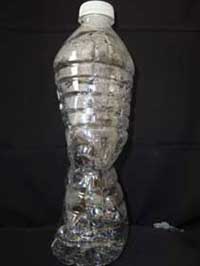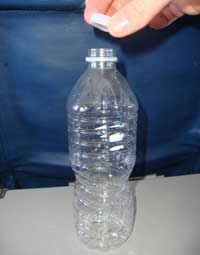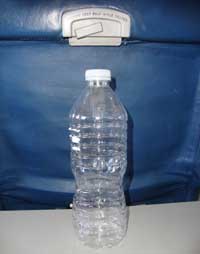Physics in the Sky: Physics on a Plane
This week we're taking a break from being home and heading to the skies! Now that boring plane ride can be filled with physics!

What you Need
- One empty disposable water bottle with a cap
- A plane ticket or a friend who will take you up in their plane
- Once you've reached your cruising altitude (about the time they turn the fasten seatbelts sign off), take the water bottle out of your carryon bag and place it .
- Unscrew the cap.

- Screw the cap back on.

- Once you land, look at your bottle. What happened to it?
What's Going On?
When you are standing on the ground at sea level, you have about 14 pounds pressing against every square inch of your body. The pressure comes from all the gas molecules that are around you that are being pulled toward Earth by gravity. You don't notice that this is happening, because that pressure is always there pushing on you and you are always pushing back against it.
The further away you get from the Earth, the less gravity there is, so the gas molecules aren't as close together and don't exert as much pressure. In fact, by the time you go into space, all of the gas molecules that are in our atmosphere don't exist because they are outside the gravitational pull from Earth. When you go up in a plane, the pressure from the air molecules decreases. So, when the bottle is open and you're hanging out in your seat at about 30,000 feet, there is less pressure both inside and outside of the bottle. Now, Mt. Everest is just shy of 30,000 feet and many people need oxygen tanks in order to summit that peak. Inside the airplane the cabin is pressurized to 8,000 feet, which is still pretty high, almost as high as Mt. St. Helens, but it doesn't make oxygen tanks one of the recommended pieces of equipment as you try to summit. The reason that airplanes are equipped with the oxygen masks that hang from the ceiling is because of the difference in pressure from 30,000 feet to 8,000 feet. If the cabin looses pressure, the masks drop so the passengers have oxygen to breath. When you screw the cap back on the bottle, you are sealing in the gas molecules that are inside the bottle, essentially capturing the air pressure from 8,000 feet above sea level. When you finally land, the air pressure on Earth is much greater than it was at in the pressurized cabin of 8,000 feet. It pushes against the outside of the bottle, but the pressure inside the bottle isn't pushing back with the same force. Since the pressure outside of the bottle is greater than the pressure inside the bottle, the bottle crumples.
Try This!- Try the same experiment if you go scuba diving. What happens?
- Try closing the bottle when you are on the ground and observing the difference in the bottle when you reach your cruising altitude in the plane.











